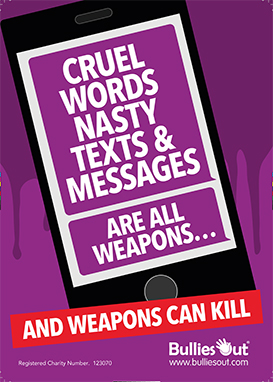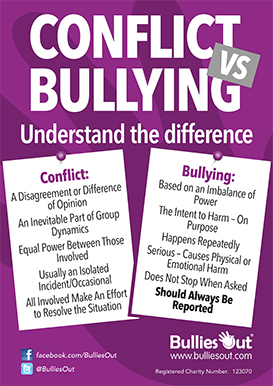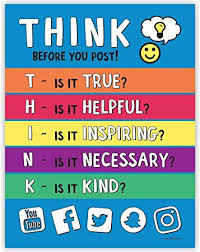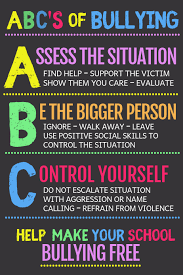Anti-Harassment - Bullying Information
Bullying



Conflict vs Bullying
Bullying: an imbalance of power, intended to harm, done on purpose, happens repeatedly, and does not stop even when asked to stop.
Conflict: a disagreement or difference of opinion, part of the group dynamics, equal between the parties involved, an isolated incident or occasional incident, all parties make an effort to resolve the incident.
Bullying and Cyberbullying
What is the definition of bullying?
The dictionary's definition of bullying is "the repeated, unwanted, aggressive behavior that involve a real or perceived imbalance of power."
In 2014, the Centers for Disease Control and the Department of Education released a federal uniform definition for bullying. To be considered bullying, the action must have these elements: "unwanted aggressive behavior that involves a real or perceived power imbalance, and a repetition of behaviors or high likelihood of repetition."
The Modes and Types of Bullying
There are two modes and four types of bullying that can occur. The two modes of bullying are direct bullying and indirect bullying. Direct bullying occurs in the presence of the target whereas the indirect bullying, the target is not present. An example of an indirect incident would be spreading rumors about the target. Within the two modes are the four types of bullying categories. The four categories are physical, verbal, relational, (the intent to harm the reputation or relationships of the target) and damage to property.
Physical bullying is not the Most common of the types of bullying. Physical bullying is the aggressive physical intimidation of the target. It often includes repeated tripping, pushing, hitting, kicking, blocking or touching in an inappropriate way.
Verbal bullying is one of the most common acts of bullying. Verbal bullying is the repeated act using cruel, demeaning words to put others down. Verbal abuse or bullying includes; name calling, racist remarks or slurs, sexist or homophobic remarks or jokes, sexually suggestive comments or abusive language of any kind.
Social bullying is also one of most common forms of bullying among children and students. Social bullying includes the exclusion from groups, spreading harmful rumors and stories about others, alienating people from social acceptance and interaction.
Cyberbullying is the least common form of bullying, however, cyberbullying is the least reported bullying and is often not recognized by adults. But cyberbullying can be just as damaging to the target as the other types of bullying. Cyberbullying can be nonstop for the victims. Cyberbullying occurs when the bully uses the Internet or other electronic medium to intimidate the target. The most common types of cyberbullying include texting, pictures or video clips with the mobile phone camera, email, using instant messaging, chat-room, and bullying via websites.
Bullying can happen anywhere. For students, the majority of incidents occur in school, on the playground, and on the school bus. Cyberbullying is primarily verbal aggression such as threatening or harassing the target and spreading rumors. But cyberbullying can also be property damage, especially when the attack results in changing the victim's privately stored electronic information.
Who are Victims of Bullying?
Children who are bullied often have one or more risk factors. Some of the risk factors include: being perceived as different from their peers. They may be overweight or underweight, wear glasses, wear different clothes, "the new kid" in school, or economically disadvantaged, they can't afford the "cool stuff." They may be considered weak or unable to defend themselves. They may be depressed, anxious, or have a low self esteem. They are not popular, have few friends, don't get along well with others, others think they are annoying or antagonist to get attention.
What are the Most Common Types of Bullying
Middle school students report higher incidents of bullying. As students get order, they as less likely to report the bullying to adults. Several studies completed in 2017 indicates that the most common types of bullying being reported by middle school students were verbal and social bullying. Physical and cyberbullying were reported less often. According to the study, students reported; "name calling, teasing, rumors and lies, pushing / shoving, hitting / slapping / kicking, being left out, threatened, stealing of belongings, sexual comments or gestures and email / online."
Effects of Bullying
According to 11 Facts about Bullying, published by DoSomething.org reports, students who report they are frequently bullied score lower in reading, math and science than their peers who report they have never been bullied or are rarely bullied. When a peer intervenes on behalf of the student being bullied, more than half of the bullying incidents stop. Finally, students who have reported that the bullying occurred at school were "related to characteristics of physical appearance, race, gender, disability, ethnicity, religion, and sexual orientation."
Be a Friend Not a Bully
T.H.I.N.K. before posting to any electronic medium.
T. - Is it the Truth?
H. - Is it Helpful?
I. - Is it Inspiring?
N. - Is it Necessary?
K. - Is it Kind?


Stop and Think before you Act
A - help the victim or find someone who can
B - use positive social skills, such as: walk away or ignore
C - don't join with the bully stand with the person being bullied
